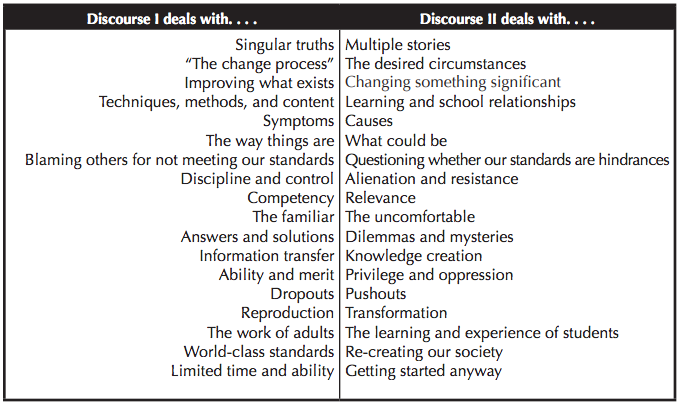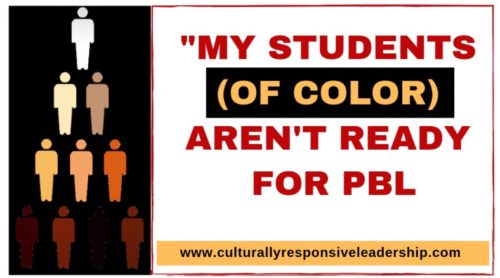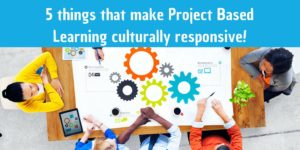My Students (of Color) Aren’t Ready for PBL – 6 Examples of Implicit Bias
Can we bring Project-Based Learning to the Hood? Most people would say no, and these thoughts are heavily based on implicit bias and White Supremacy Culture. Culturally responsive leaders must be prepared to call it out and reframe the work of moving towards deeper learning.
I was re-inspired to push for Deeper Learning by an EdWeek article entitled, “Why Equity Has Been a Conservative Force in American Education, by Jal Mehta. Jal writes, “The consequence of holding everyone accountable to low level tests in reading and math, without building any of the supporting structures, climate, or culture that would enable those results, in that schools serving disadvantaged students narrowed the curriculum and focused disproportionately on test prep, whereas more advantaged public schools and private schools had flexibility to continue offering a richer and more holistic educational approach.”
In reality, this looks like cutting arts and elementary science. Also, it looks like double classes of math/ELA and teaching to the test. On the other hand, we expect that deeper learning is needed for privileged students. Jal, in his piece also brings up Duncan Andrade, Valenzuela, Freire, and Shane Safir. Let’s just say it got me all kinds of excited. This work is about justice. Both in content, application of learning, and in the act of implementing PBL in the hood and in the woods (rural schools).
We are Trying to Bring PBL to the Hood
Our school, Visitacion Valley Middle School, is in our third year of piloting PBL, whole school. Despite our partnership with New Tech Network, High Tech High, support from our central office, and financial support from corporate donors, it’s still so hard to stay focused on academics.
In education, we throw around words like ‘inner city’, ‘underserved’, ‘high-trauma’, ‘at-risk’, and ‘Title 1.’ These are all ways to describe a tough school. Yes, we are trying to close the opportunity gap, and but we (at my school) are trying to give access and opportunity to students coming from the hood. I believe that PBL, as well as other key pieces of an equitable education, are instrumental is giving marginalized students access to fully participate in our society. I’ve written about how PBL is culturally responsive teaching.
That being said, it’s Springtime in a Middle School, and times are tough. Days are long and nights not long enough to recharge. Students are pushing lines, teachers are trying their best, and on some days it feels like we are just trying to get through the day. Suffice to say, it’s hard to stay focused on teaching and learning. I’m not even talking about trying new things and deeper learning. So PBL is a lot to attempt.
Energy is waning, and folks might be cruising Craigslist. When we continuously experience vicarious trauma, we turn on each other and we turn on the kids. Like many Spring semesters, we are moving to talk about systems, consequences, climate/culture. It’s needed, because it’s foundational to learning. Further, there is an urgency to focus on controlling poor brown students. We have been socialized to do this.
But our underserved students need to be served not controlled.
Students need to be taught to apply skills to the real world, not just how to act right. (Especially if “right” is defined by white middle-class norms)
6 Examples of Bias – Racism Disguised as Resistance
These deficit mindsets are the rebar of white supremacy culture that holds together our public education structure. They present like honest questions, playing “devil’s advocate,” and “honest” worries, but there is something far more sinister beneath the surface. The following are a few comments that I’ve heard over the past few years, in different places from people in different positions. I added connections to tenets of white supremacy culture (in green below) that brainwashed us all into believing what is/isn’t possible.
- “But is it rigorous?” “Is it standards-aligned?”– This assumes the ‘objectivity‘ of standards, and is an example of ‘worship of the written word.’ I wonder, Why automatically cast doubt on creative ideas? Who stands to benefit from this mentality? Not to mention that you can design a deeper learning unit that is aligned to standards and still engaging. Don’t fall into “either or thinking.”
- “My students are too chaotic” – This is influenced by ‘paternalism‘ of teachers (often white) and ‘power hoarding‘, usually of poor brown children. Why are we obsessed with controlling students of color. PBL is supposed to get kids moving, because it aids in learning, building community, and it’s what bodies are for. MOVEMENT. The fear of students moving unearths our fear of turning over power to the children. Less they take over their own learning. Affluent, charters and suburban schools call this “personalized learning,” and apparently its ok for them. I say us too.
- “My students (of color) aren’t ready for PBL.” “We have to get the basics done first” “It won’t raise test scores” – This assumes that students don’t have basics, and keep them perpetually being in remedial classes. This positions the income/racial hierarchy next to Bloom’s taxonomy, leaving poor brown folks at the bottom of each pyramid. (Paternalism) Mentioning test scores assumes that there is one way to assess learning and students of color need the shallow version.
- “It doesn’t prepare students for elite colleges” – The assumption here is that there is only one form of higher education, and that our most elite (usually with the strongest tenets of white supremacy culture) should drive what all other colleges do, and subsequently K-12. Let’s let them stop leading from the ivory (pun intended) tower. This is another examples of ‘paternalism‘
- “Group work is lowering the bar” – This mentality prioritizes ‘individualism‘ over collectivism. Zaretta Hammond, writes much about the benefits of using a collectivist approach to learning, to maximize how the brain learns best, and how students of color can tap into their indigenous practices. Individualism takes away their power and raises their affective filter.
- “We won’t get through enough content” – This is a perfect example of ‘sense of urgency‘ and ‘quantity over quality.‘ It’s also paternalist to assume that you have all the answers to what content matters as well as what skills are needed. Let alone someone miles away who doesn’t know the context, reality, or interests of your students. Take back the power. If affluent kids deserve depth over breadth, so do poor kids. I would argue more depth so that they can see the purpose of learning and to allow for cross-curricular connections.

Many of these comments, if not all, are examples of Discourse 1, the language of deficit thinking and the doublespeak of white supremacy culture.
Mind you, these questions aren’t as common in affluent, white, innovative charter, suburban, private, or alt schools. Why? It is assumed that kids in those schools are capable of critical thinking, 21st century leadership skills, and deeper learning. Why? In short white supremacy culture, racial hierarchy, and bias. For an extended version, read Mehta’s blog.
Data Driven Decisions
To add insult to injury, my school was named as one of the lowest performing schools in California. The truth is that I hoped our “satellite data” would increase during my tenure here, but it hasn’t budged enough for the big wigs to notice. As if it wasn’t hard enough already. What am I supposed to do with that? Yell at teachers? Hell at students? Sulk? Beat up on myself? Look for a quick fix? Teach to the test?
Nah homie.
Instead, I’m going to double down and bet on black. Ima let it ride with PBL and Social Emotional Learning.
Are we making progress? Sure. I see classroom engagement and student collaboration changing, and our reading proficiency increasing, but the big data is lagging. I do believe that it takes time to raise those scores. Conditions of adult learning and anti-racism must be built. Structural changes like redesigning bell schedules and remodeling furniture must be made. Academic/Behavioral Intervention must be part of the program. And finally, teachers need space, time, and support to teach.
Counter-Narratives with Newcomer Students
Our school serves students who are new to the country, some coming with interrupted years of education. Students are still working on developing their English proficiency, and in most schools, they would be relegated to worksheets, textbooks, and building the basics.
However, our Newcomer teachers are pushing their students to develop collaboration and written communication skills. This year, Teachers worked together to develop 3 cross-curricular projects.
- Students designed methods of preparing for an earthquake, while reading about them in ELA class.
- Students told their immigration stories to our non-newcomer students, using multimedia.
- Students designed an app on google slides, to explain their learning objectives and school expectations to their parents, with translation into their home language.
Why is this huge? Newcomer students are collaborating, reading, writing, and applying those skills to real-world problems. Teachers are designing student-centered learning experiences and engagement is up! Level up! And they used the ELD Standards and content standards. Further, Teachers broke down the walls of their classes and collaborated. Kaboom.
Conclusions and Call to Action
So look, if you are trying to engage disenfranchised and oppressed students in deeper learning, you are gonna encounter resistance. These thoughts are guided by unexamined tenets of white supremacy culture. But it’s possible and necessary.
Fight this battle in the mind, through growing consciousness and developing racial literacy. Don’t fall for the doublespeak or fall into the pitfalls of conservative thinking.
When someone says, my students aren’t ready for PBL. Ask them to specify which students. Is it the students of color? Then ask them what leads you to believe this? Point out the mindsets that are muddying the waters, and invite them to leave the land of deficit thinking.
Frame your deeper learning work with a clear equity imperative, one that places student empowerment and student engagement at the center. Students of color should be climbing up the pyramid of racial hierarchy AND bloom’s taxonomy. Let’s help by removing the barriers, especially the ones we are creating.
Teachers, confront your bias and engage with your students and community. Reach out to the student you struggle to connect with. Figure out their interests and center the content around them.
Culturally responsive leaders, it’s time to engineer for equity!
Stay Connected and Updated
Resources
Organizations to partner with
Some key PBL books
- Project Based Teaching
- Transforming Schools with PBL
- Deeper Learning



